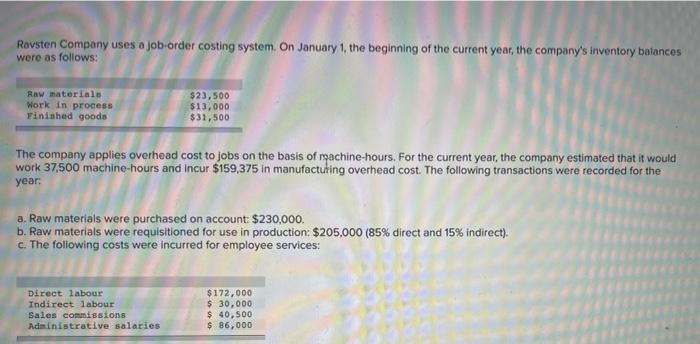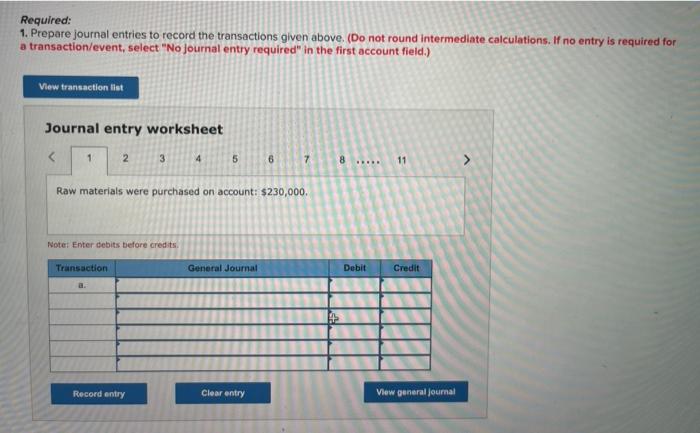Ravsten Company uses a job-order costing system. On January 1, the beginning of the current year, the company's inventory balances were as follows: Raw materials Work in process Finished goods $23,500 $13,000 $31,500 The company applies overhead cost to jobs on the basis of machine hours. For the current year, the company estimated that it would work 37,500 machine-hours and incur $159,375 in manufacturing overhead cost. The following transactions were recorded for the year: a. Raw materials were purchased on account: $230,000. b. Raw materials were requisitioned for use in production: $205,000 (85% direct and 15% indirect). c. The following costs were incurred for employee services: Direct labour Indirect labour Sales commissions Administrative salaries $172,000 $ 30,000 $ 40,500 $ 86,000 d. Heat, power, and water costs were incurred in the factory: $48,750, e. Prepaid insurance expired during the year: $17,500 (80% relates to factory operations, and 20% relates to selling and administrative activities). f. Advertising costs were incurred, $57,500. g. Depreciation was recorded for the year. $69.000 (75% relates to factory operations, and 25% relates to selling and administrative activities) h. Manufacturing overhead cost was applied to production. The company recorded 43,000 machine-hours for the year, 1. Goods that cost $525,500 to manufacture according to their job cost sheets were transferred to the finished goods warehouse j. Sales for the year totalled $769,800 and were all on account. The total cost to manufacture these goods according to their job cost sheets was $517,500. Required: 1. Prepare journal entries to record the transactions given above. (Do not round intermediate calculations. If no entry is required for a transaction/event, select "No journal entry required" in the first account field.) View transaction list Journal entry worksheet 1 2 3 4 5 6 7 8 ..... 11 > Raw materials were purchased on account: $230,000. Noter Enter debits before credits Transaction General Journal Debit Credit Record entry Clear entry View general Journal 2. Prepare T-accounts for inventories, Manufacturing Overhead, and Cost of Goods Sold. Post relevant data from your journal entries to these T-accounts (don't forget to enter the opening balances in your inventory accounts). Compute an ending balance in each account Raw Materials Manufacturing Overhead Beg Bal Beg Bal End. Bal. End. Bal 0 Work in Process Cost of Goods Sold Beg. Bal. Beg. Bal End. Bal. 0 End. Bal. 0 Finished Goods Beg. Bal End. Bat. 3-a. Is manufacturing overhead underapplied or overapplied for the year? Overapplied overhead Underapplied overhead 3-b. Prepare a journal entry to properly dispose of any balance in the Manufacturing Overhead account. (Do not round intermediate calculations and round your final answers to 2 decimal places. If no entry is required for a transaction/event, select "No journal entry required" in the first account field) View transaction list Journal entry worksheet Record the entry to properly dispose of any balance in the Manufacturing Overhead account Note: Enter debits before credits Event General Journal Debit Credit 4. Prepare an income statement for the year. (Do not round intermediate calculations and round your final answers to nearest whole dollar amount.) RAVSTEN COMPANY Income Statement For the Year Ended December 31 0 Selling and administrative expenses 0 $ 0












